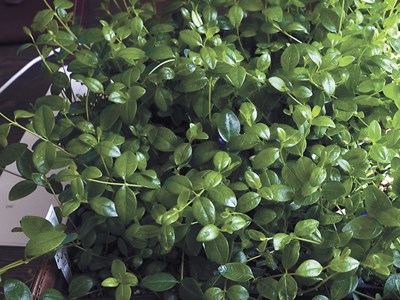I’m playing a really interesting game of “musical rooms” since I brought home a tray of periwinkle from the greenhouse last week.
I had received the Botanix flyer in last week’s Northern Life, and saw that the very thing I needed for my garden was on sale. Since I needed a lot of them, I knew I had to make the drive. Snowstorm be damned!
When I arrived at Botanix, I was the only soul around. I kicked the snow off my wellies and entered the shangri-la: lilacs scented the room and the temperature was balmy. I had questioned my good sense on the drive out, wipers working madly at the snow.
But the entranceway alone confirmed that my good sense was indeed intact. A breath of fresh greenhouse air was just what I needed.
I picked up my periwinkle—36 in total (six trays, six plants per tray)—and some Mykes, a beneficial fungi that encourages root growth. The trick is going to be ensuring the survival of my new plants in my drier, cooler home.
So far so good, I must say. But there certainly is a lot of moving to and fro: away from the cat, into the shade, out of the wind. Repeat until dizzy.
Periwinkle (vinca minor) is an excellent groundcover that spreads quickly in the right conditions.
In May, I’ll be planting them on my hillside, which is well drained and shady. The soil is good—years of leaves breaking down being the direct cause--but is prone to erosion. The inclusion of this plant should remedy the loss of soil.
Periwinkle is an evergreen vine, which means, come spring, they’ll be green and ready to flower. They’re not just any green; they’re a rich, glossy green that beam with good health. The flowers are a light purple, and shoot forth like stars from a virescent galaxy. Lovely.
When I plant them, after weeks of tending indoors, I’ll be sure to plant some of the vine itself. If the stem is covered, they’ll produce roots that will encourage spreading. I’ll make sure to keep them evenly watered for this first season to ensure their adoption.
But too much moisture can lead to a stem blight that can be ruinous for the plant. The hillside sees excellent drainage, so it shouldn’t be a problem for me. Keep that in mind if your considering periwinkle for your own home. Too much direct sun can slow down the otherwise vigorous growth. Dappled light to full shade is best.
As with any vigorous spreaders, recall that periwinkle can be invasive (like my good friend the gout weed); if you are concerned about a coup, then create a border through which the plants may not enter. Just keep an eye out, is all.
So far, I’m impressed with the overall appearance of my garden. Nothing untoward really catches my eye, save for the swath of brown mud. Once the periwinkle works her magic, I may have the most enviable hillside north of the French River.
Anne Boulton is an avid gardener who lives in Sudbury. Visit her blog at greenboots.ca or contact her at [email protected].
Posted by Vivian Scinto
Join Sudbury.com+
- Messages
- Post a Listing
- Your Listings
- Your Profile
- Your Subscriptions
- Your Likes
- Your Business
- Support Local News
- Payment History
Sudbury.com+ members
Already a +member?
Not a +member?
Sign up for a Sudbury.com+ account for instant access to upcoming contests, local offers, auctions and so much more.
